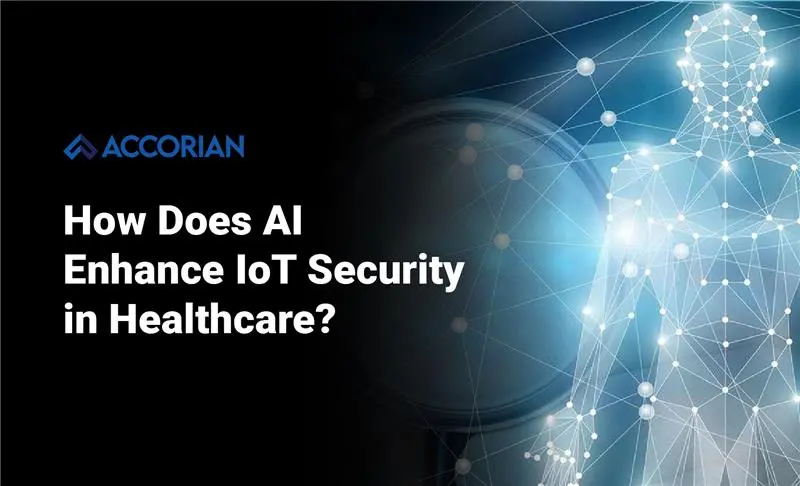Integrating IoT (Internet of Things) has transformed healthcare by enhancing patient care, streamlining operations, and improving outcomes using smart wearables and clinical tools. However, some of these upgrades have also resulted in increased security risks. Artificial intelligence (AI) is critical for safeguarding IoT devices and preserving sensitive healthcare data. This article delves into how AI investigates cybersecurity challenges in healthcare and highlights AI-driven solutions to these threats.
What is IoT in Healthcare?
IoT in healthcare is a network of smart devices that collect, share, and analyze medical data to improve patient care. This includes applications such as fitness wristbands, patient treatment and monitoring systems, smart implants, and equipment such as infusion pumps and ventilators.
These devices drive the healthcare revolution by allowing for data-driven decisions, remote monitoring, and individualized care. On the dark side, the IoT coupling opens new vulnerabilities that can be exploited in a cyberattack.
AI and Its Growing Role in Cybersecurity
AI’s rapid data processing and analysis capabilities have transformed cybersecurity, with technologies like Machine Learning and Deep Learning seeing a rise because they are superior to traditional paradigms in terms of pattern recognition, anomaly detection, and threat adaptation.
IoT aids in evaluating the device’s behavior and unusual practices to generate predictive insights for the purpose of preventing breaches from occurring. However, before examining specific use cases of AI, we should pay attention to the challenges concerning the use of IoT in the provision of healthcare.
AI and Its Growing Role in Cybersecurity
AI’s rapid data processing and analysis capabilities have transformed cybersecurity, with technologies like Machine Learning and Deep Learning seeing a rise because they are superior to traditional paradigms in terms of pattern recognition, anomaly detection, and threat adaptation.
IoT aids in evaluating the device’s behavior and unusual practices to generate predictive insights for the purpose of preventing breaches from occurring. However, before examining specific use cases of AI, we should pay attention to the challenges concerning the use of IoT in the provision of healthcare.
Security Challenges in IoT for Healthcare
Despite offering numerous benefits, IoT in healthcare creates a one-of-a-kind viewpoint full of difficulties, mostly arising from the intricacies and sizes of interconnected systems. Here are some of the most important challenges:
1. Huge Attack Surface: Each IoT device is a potential target, and as their prevalence in healthcare grows, so does the risk.
- Real-World Example: A recent report by Palo Alto Networks found that 83% of medical IoT devices ran on outdated operating systems, making them prime targets for cybercriminals.
2. Sensitive Data at Risk: Medical records, biometric data, and other health metrics are all sensitive patient information that IoT devices gather and transmit. When a patient’s privacy is breached, this may result in legal and financial ramifications for healthcare providers.
3. No Uniformity: IoT devices come from various vendors, each with its own set of security standards. Often, these varied deficiencies complicate the protection of the IoT ecosystem.
- Real-world example: Using IoT devices from different manufacturers poses challenges for healthcare providers in implementing standard security measures, thereby increasing potential cybersecurity threats.
4. Outdated Devices and Systems: Many healthcare institutions still use outdated devices that lack security features, making them more prone to attacks.
5. Necessity to Operate in Real Time: IoT devices perform life-critical procedures in healthcare, and a cyberattack during this process can directly jeopardize patients’ safety.
6. Regulatory Compliance: For an organization within the healthcare ecosystem, compliance with regulations such as HIPAA, GDPR, and other industry standards is mandatory, adding complexity to the existing IoT security challenge.
Why Traditional Security Measures Fall Short
Conventional cybersecurity approaches often overlook the complex and decentralized aspect of IoT environments. Designed for structurally centralized systems, these techniques struggle to track real-time data flow and manage the wide range of linked devices in IoT environments. This is where AI plays a transformative role.
A Case Study on The Shortcomings of Traditional Cybersecurity Measures (The WannaCry Ransomware Attack)
Here’s a case study that demonstrates why AI-powered cybersecurity measures are essential for protecting modern healthcare environments from evolving cyber threats.
A notable example of healthcare technology is the Forrester Healthcare eBusiness Report 2023, which explained how the 2017 WannaCry Ransomware Attack brought down several devices while preserving environmental security. This ransomware attack spread over more than 150 countries, affected over 200,000 computers, and caused around $4 billion in global damage. The UK National Health Service (NHS) was one of the most severely impacted, with hospital operations disrupted, patient treatments delayed, and thousands of critical surgeries canceled. The attack exposed serious flaws in outdated medical systems as well as the risks associated with networked medical devices such as infusion pumps and patient monitoring systems.
The facility’s promotional efforts were discontinued due to a sudden halt in meetings and hospital lockdowns, which resulted in the redirection of services. Traditional cybersecurity measures based on rule-based detection struggled to process vast IoT data in real-time and required manual intervention. These traditional methods also failed to address zero-day threats, making healthcare organizations susceptible to advanced cyberattacks. Conversely, AI-powered security solutions use machine learning-based adaptive detection that watches IoT network traffic in real-time to actively prevent unknown threats while allowing automatic threat response.
Key Lessons from the WannaCry Incident:
- Outdated Software: Many retrograde sovereign facilities were left exposed to thousands of devices.
- Monitoring Capabilities: Traditional security procedures were inadequate to prevent WannaCry due to the lack of real-time monitoring, which may have slowed its progress.
- Auxiliary Effect of the Attack: The operations of a staff were not only interrupted by the attack, but it was also life-threatening. A clear example would be an urgent intervention where critical medical data could not be accessed or IoT devices utilized to supervise a patient could not be used.
- Networks that Need AI Most: If AI-powered systems were deployed, they would have been able to detect the malware in advance by tracking network activity and traffic patterns. Before WannaCry spread, AI could have identified unusual data encryption patterns as suspicious, enabling early intervention.
- Post-Incident Changes: Following the breach, healthcare providers upgraded facilities, increased patching frequency, and implemented AI for cybersecurity, emphasizing the critical necessity for preventative actions in IoT contexts.
The Role of AI in Addressing These Challenges
AI has the ‘never-before-seen’ perspective to solve the IoT security difficulties confronting healthcare due to its more versatile design. Here’s how AI can be beneficial:
- Autonomous response and remediation: AI growth allows for a continuous learning cycle, ensuring device intelligence. While AI is dealing with a particular security incident, it is also learning, thus aiding in future defenses more effortlessly.
- Automated threat detection: AI not only can fight against the identified attacks but is also capable of including threat identification and hunting through behavioral pattern recognition on the network.
- Artificial intelligence real-time threat management: Irregularities in network usage can always be checked in detail by a person or an automated system but need to be recorded in either case.
Next Steps and Best Practices
Healthcare organizations aiming to implement an effective framework for IoT security should follow these best practices in the following areas:
- Schedule exposure mitigation and vulnerability scans on a routine basis.
- Establish an IoT risk governance plan.
- Stay updated with the changes to always remain one step ahead of the threats.
Conclusion
As the healthcare sector becomes increasingly reliant on IoT, ensuring robust security is no longer optional, it is a necessity. AI-driven security solutions offer a proactive approach to monitoring, detecting, and preventing cyber threats before they can cause harm. Healthcare institutions must invest in AI-powered cybersecurity frameworks, establish IoT governance policies, and conduct regular security audits to safeguard patient data. By embracing AI, healthcare providers can ensure a safer, more resilient IoT ecosystem that enhances patient care while mitigating cyber risks.


